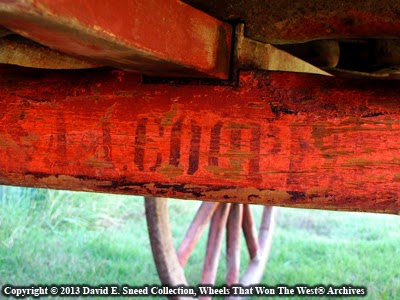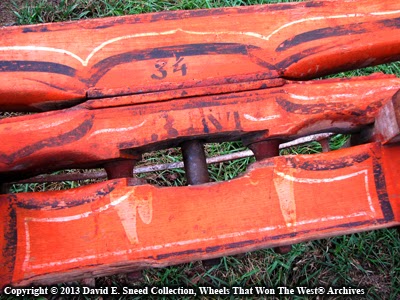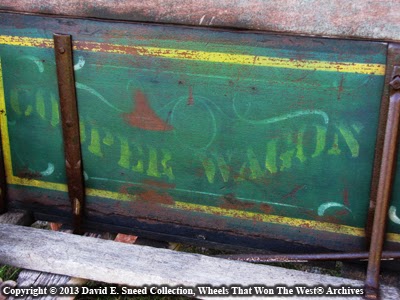When it comes to locating early wagons for collections, many folks wonder where to start. Over and over I'm asked, "How do you find collector grade wagons?" The answer is easy to share. The process involved, though, can be a lot more difficult. The real secret to finding these vehicles is to never stop searching for them. Honestly, that's it. You never know when one is going to pop up. It's a little like a 'jack-in-the-box' toy you might have played with as a kid. You're turning the crank, hearing the music, and you know from experience that the thing is going to pop up - yet, it still has a way of surprising you.
Before you can search, however, it's important to know what to look for. While this statement sounds simple, it's the part of the process that can be considerably more difficult. In fact, it can take years to learn how to interpret a vehicle's identity, condition, originality, features, and overall desirability. There are so many important distinctions of early wagons because the industry was vast and the time periods covered are extremely broad. Equally challenging, makers frequently had multiple ways of building the same or similar pieces and, to make matters worse, truly authoritative information can be frustratingly hard to locate. Once you have a direction for the search, though, the history chasing can begin. I usually supplement my quests for the rarest wagons by putting out the word that I'm interested in a particular brand and just hope that enough paint has survived to make the vehicle easier to recognize without doing extensive research.
With that as the backdrop to this blog,I can say it was a day like any other when I received an email from Doug Hansen of Hansen Wheel & Wagon Shop. He knows how to get my attention. The email was short... only one photo with a single word question - "Interested?" The photo showed a close-up of a wagon logo on a sideboard. The brand name shown was 'Cooper'. Now, I had been looking for a Cooper wagon for years and I'd shared that with Doug quite some time ago. While I've spent a fair amount of time studying early Cooper literature and have stumbled across a few 20th-century-built spring seats, I had never been this close to an original Cooper vehicle.
This set of wheels had a number of early distinctions and was just one day from selling at an estate auction. High narrow wheels, wide original floorboards, a through-bolted gear, and a period box brake were among its notable attributes. Best of all, the wagon was relatively untouched by modern restoration attempts. The first thing I needed to do was confirm the originality of the gear to the box. The design clearly pre-dated those shown in a commonly reproduced 1915 P & O catalog. Based on comparisons with additional period imagery from our Wheels That Won The West® Archives, the piece appeared consistent with what was produced during the 1880s and 1890s. Only with sufficient high resolution photos or a first-hand inspection would I be able to narrow down the manufacturing date and also confirm whether the box and gear were mates. Unfortunately, I wasn't able to get that kind of access before it sold. Nonetheless, I took a chance and bought the piece.
Once I had it home, it was easy to see that the wheels and gear were covered in an extremely old repaint job; not uncommon as many early farmers took care of their vehicles (especially the gears) by repainting when the original colors started to wear. Over the years, I've discovered a method that allows the removal of the different paint layers. Combined with a little elbow grease, the old supplements of barn paint on this wagon came off nicely. Beneath the surplus red coating, I found a significant amount of original orange paint along with the correct black stripes and white pinstripes. Not only do all of the design elements on the gear match up with early Cooper imagery but the skeins, themselves, are cast with the initials AAC. That lettering represents the name of the company president and founder, A.A. Cooper - which is the way most early literature referred to the company. The final piece of evidence confirming the originality of the gear and box as mates made itself clear when I uncovered the stenciled A.A. Cooper name on the rear axle.

After reviewing the piece further and comparing multiple features with Cooper's design and construction variations from the 19th century, it's clear the wagon will date sometime shortly after 1885. A supportable timeframe of manufacture would be the late 1880s to near 1890. The taller 54-inch rear wheels, original paint, pinstriping, and logos on the box and gear as well as a patented cold-rolled steel brake ratchet and also a factory serial number further reinforce the uniqueness of the piece. Combined with period government records listing Cooper as among the very best makes (only Peter Schuttler and Bain were ranked higher in this 1880 record of competitors for government contracts*), it was a relatively easy decision to add the vehicle to the Wheels That Won The West® collection.
How many more nineteenth century Cooper wagons with original paint and serial numbers still exist? It's hard to say. I've heard rumors of others but it's taken me nearly two decades to actually locate one. The real reward is the knowledge that another relevant piece of early American transportation can now be preserved for generations to come. Well-known on the American frontier, Augustine A. Cooper made a complete line of carriages, wagons, and sleighs. It's appropriate, then, that this Cooper wagon should join a number of other extremely rare vehicles in our collection, each helping interpret the way it was... when opportunity ruled and wagons rolled throughout the American West.

*1880 Government deposition. For additional information within another contemporary publication, see "Wagons For The Santa Fe Trade" by Mark L.Gardner.
